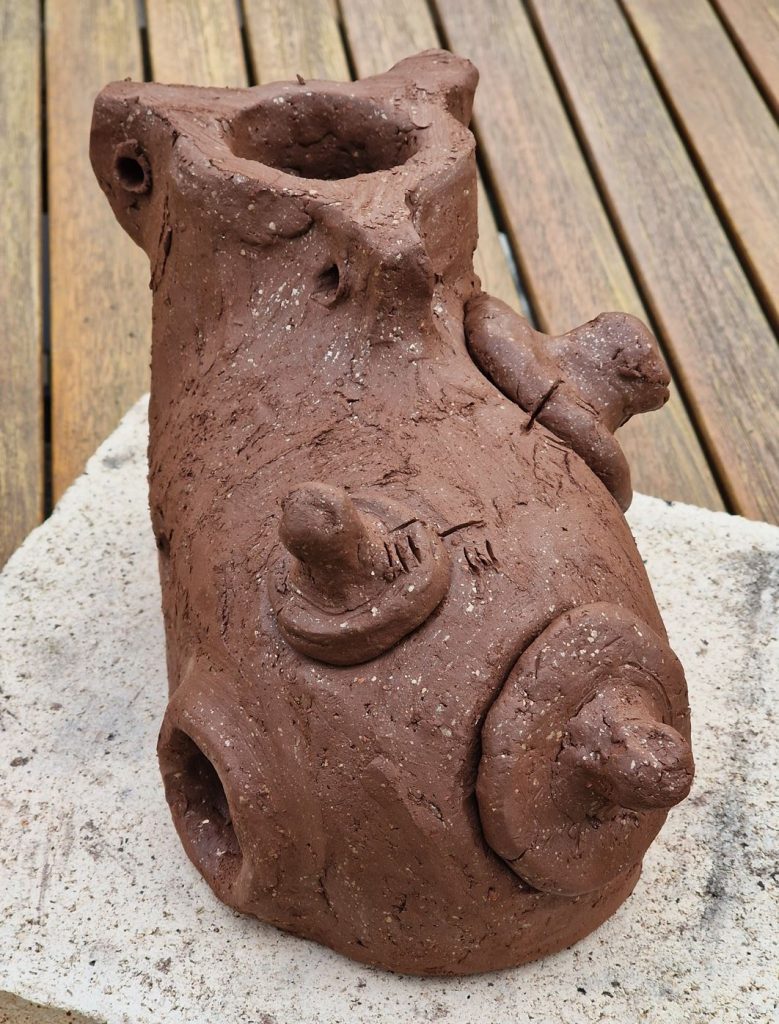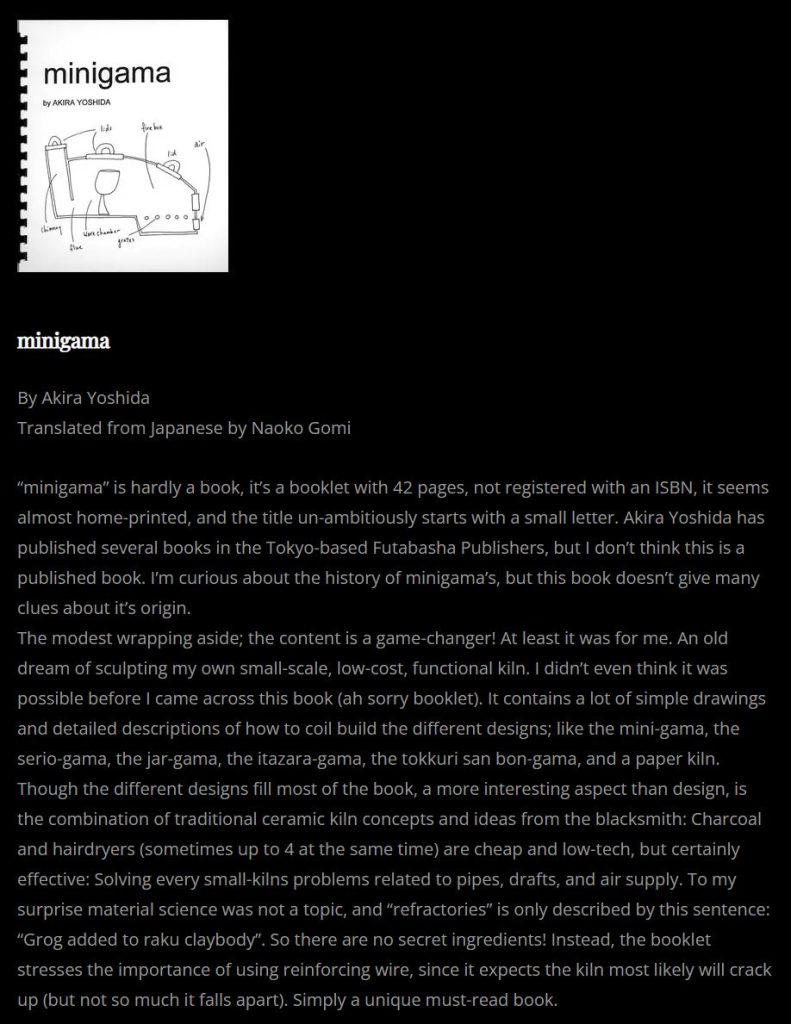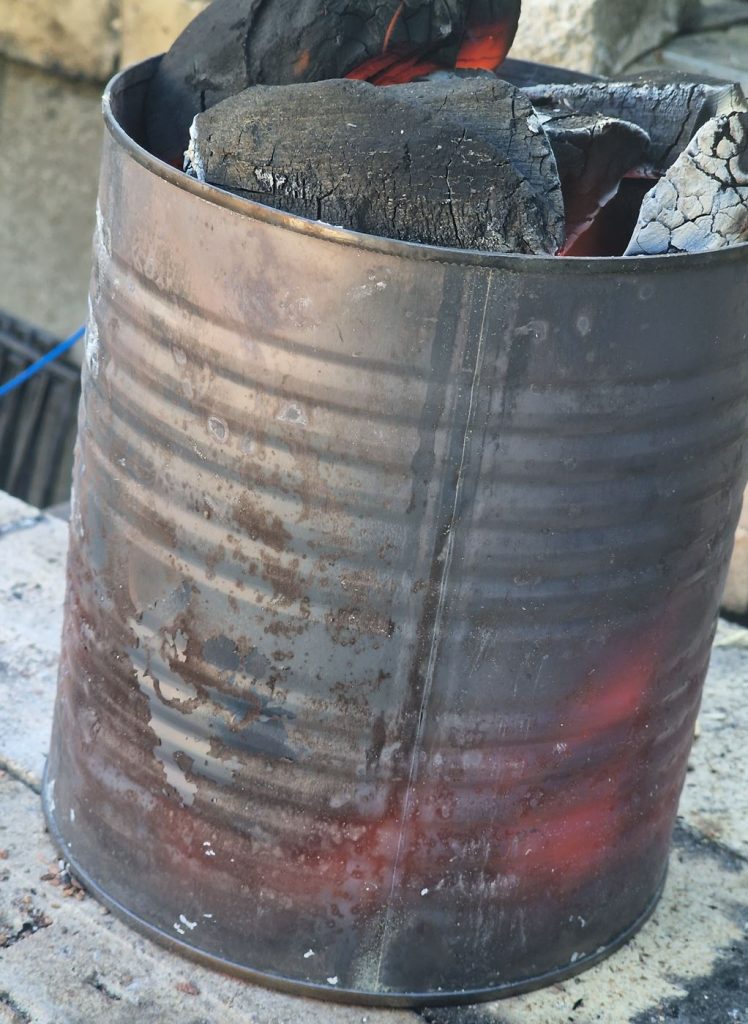
My concept sketch, or mini-miniagama pottery kiln.
The Minigama Pottery Kiln – How to build the Mini Kiln
The Minigama pottery kiln is a radical design and a new way of thinking about flame-kiln design. Where electric and industrial kilns stepped away from 10’000 years of wood firing practice, the Minigama pottery kiln is a rebellious design in a classic flame kiln tradition.
Minigama, the New Mini Kiln:
The English book “minigama”:
It is a small booklet, which I do believe only translates a small fraction of Mr. Akira’s expertise about Minigama’s from Japanese to English. The booklet gives no hint if Mr. Akira is the inventor of the Minigama or the story about this kiln’s origin.
The author and ceramist Akira Yoshida has written many books in Japanese, also about the Minigama and other mini-kilns. Out of reach for those who don’t read Japanese: https://www.amazon.com/stores/Akira-Yosida/author/B004LP9V1O
This is the front cover of the English booklet:

According to the descriptions in Akira Yoshida’s book, a Minigama is a small 50-centimeter pottery kiln hand-built with traditional Raku clay. After it’s dried and burned, it’s ready to be used as a “one Sake cup” ceramic kiln, and can reach 1200 degrees Celsius in about 3 hours. This makes it an interesting quick, low-cost test kiln. I guess the name Minigama is a humorous comment on the traditional Asian Anagama kiln, which it also borrows a few concepts from. To make sufficient airflow into this small kiln, it uses a hairdryer to blow air under the charcoal (the combustion material of choice). In my opinion, this simple idea combines traditional ceramic kiln concepts with ideas from the blacksmith. It’s such a simple construction, but it redefines the principles of the traditional pottery kiln. If a motor makes the pressure, you don’t need a draft, if you don’t need a draft, you don’t even need a pipe. Every wood-fired kiln tries to balance the air intake, the firebox, and the wares chamber, against the pipe, to make the right draft. But the hairdryer is the new kid on the block. The Minigama has absolutely some challenges of its own, blowing directly into the fire makes sparks spray around like a Fontane, and a kiln built in clay is just doomed to crack (or worse). Still, this is a dream come true. It is possible to model your own mini wood-fired kiln that works! (with some issues).
I have built a mini-kiln quite like the minigama, but using a different design. The core functionality is inspired by the Minigama book. Read here about how it’s built and how to make the refractories:
coil-building-the-clay-kiln/
This is my review of the minigama booklet:
best-books-about-wood-fired-pottery/

Another low-cost kiln worth taking a look at is the Tin Can Kiln, which has some clear similarities with the Minigama pottery kiln:

https://www.woodfireceramic.com/build-a-mini-tin-can-pottery-kiln/
One question that makes the Minigama so interesting is why this small device can reach high temperatures in just three hours? Sure, the hairdryer makes a fire on steroids. But that’s just part of the answer, and I think the thin walls are another reason. Thick walls with a huge isolating potential also take a lot of time to heat up. The Minigama hardly has mass to heat up. As an example, dug-out-sandbank-kilns take many days to fire, not necessarily because the pottery needs it, but it’s the time needed to heat up the surrounding sand to high enough temperatures.
So the flames themselves are hot enough; it’s all about encapsulating them, but thick encapsulation also needs to be heated.
Read more about flame temperatures on Wikipedia:
https://en.wikipedia.org/wiki/Flame
I’m convinced it’s possible to mix together a Fireclay for the Minigama that works well for hand modeling, handles the heat, and doesn’t crack up when fired. Here, I try to find the right materials mix for the projects.
Making Fireclay for the Minigama:
https://www.woodfireceramic.com/how-to-make-fireclay/
Minigama Pottery Kiln – A Radical Design
The pipe traditionally makes the draft. As this picture shows, a 14 cm high pipe, with a 6 cm inside diameter, makes enough draft to “vacuum” in flames, making them 2 – 3 times higher out from the pipe to the right, than from the opening to the left. Both openings have the same diameter. The Minigama pottery kiln doesn’t need a pipe to make a draft, since the hair dryer pushes the air into the kiln.

Different Minigama movie clips I found on YouTube:
Links on the Internet:
https://elenorwilson.blogspot.com/2013/07/small-japanese-kiln-sequel.html
CMU 442 Kiln Construction Jake Allee: Project 1 (alleekilnclass.blogspot.com)
Minigama Pottery Kiln – The New And Radical Mini Kiln – 2025